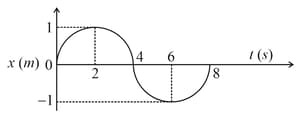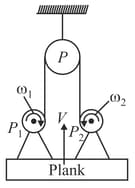Velocity and Acceleration in Simple Harmonic Motion
Velocity and Acceleration in Simple Harmonic Motion: Overview
This topic covers concepts, such as Equation of Velocity in Terms of Time, Equation of Velocity in Terms of Displacement, Equation of Acceleration in Terms of Time, Equation of Acceleration in Terms Displacement, etc.
Important Questions on Velocity and Acceleration in Simple Harmonic Motion
A particle performs S.H.M. with amplitude . The speed of particle is doubled at the instant when it is at distance from mean position. The new amplitude of the motion is
The graph of a particle performing simple harmonic motion is shown in the figure. The acceleration of the particle at is:

If velocity of body is half the maximum velocity. Then what is the distance from the mean position?
Two particles P and Q of equal masses are suspended from two massless springs of force constants and respectively. If maximum velocities during oscillation are equal then the ratio of amplitudes of P and Q is
If the maximum velocity of a particle performing S.H.M. is , then the average velocity during its motion from one extreme position to the other will be
Velocity of a particle moving along a straight line at any time is given by . Find out the distance travelled by the particle in the first two seconds.
A body is executing simple harmonic motion. At time , the positon and acceleration of the body are and , respectively. If , then the angular velocity (in )
A hydrometer executes simple harmonic motion when it is pushed down vertically in a liquid of density . If the mass of hydrometer is and the radius of the hydrometer tube is , then the time period of oscillation is
The ratio of the magnitudes of maximum acceleration to the corresponding velocity of a body undergoing simple harmonic motion, is
The velocity of a particle executing SHM, while passing from its mean position is . If its amplitude is doubled, without changing its period of oscillation, its velocity at the mean position will be
A body starts moving on -axis from rest from . Acceleration of the particle varies according to the equation
for
for,
Where is the position vector of the particle at any instant . Then velocity of the particle at is
Figure shows the graph of velocity versus displacement of particle executing simple harmonic motion. The frequency of oscillation of the particle will be

If , then find .
The velocity of a particle, executing S.H.M, is at its mean position.
The displacement of two particles executing S.H.M are represented by and . The phase difference between the velocities of these particles is
In the figure shown two motors fixed on a plank which is hanging with light string passing over fixed Pulley . If the motors starts winding the thread with angular velocity & then velocity of plank is (here are the radii of motor rotor respectively) [Given: ]

Which one of the following is the correct acceleration vs. time graph for a particle performing SHM?
Which one of the following is the correct graph for acceleration vs. displacement of a particle performing SHM?
The shape of velocity vs. time graph for a particle performing SHM is
A particle performs simple harmonic motion. A large number of snapshots of its position are taken at random. A histogram of these positions will
